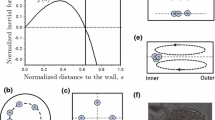Abstract
A simple microbioreactor for high-throughput bioprocessing made from low cost polymer polytetrafluoroethylene (PTFE) tubes with a working volume of 1.5 ml is described. We have developed a microfluidic system that handles a small population of cells of a model microorganism, Pseudomonas aeruginosa DS10-129. Under the conditions of the microbioreactor, the organism produced extracellular secondary metabolites by using nutrient broth modified with glycerol. Pyocyanins were isolated from the fermented medium as a metabolite of interest. Antibiotic properties of pyocyanin were effective against a number of microorganisms such as Staphylococcus aureus, S. epidermis, Bacillus subtilis, Micrococcus luteus and Saccharomyces cerevisiae. Batch fermentation of the model organism in the microbioreactor was compared to shake-flask and conventional bench fermenter methods. Results obtained from the microbioreactor compared favourably with the conventional processes.


Similar content being viewed by others
References
Baron SS, Rowe JJ (1981) Antibiotic action of pyocyanin. Antimicrob Agents Chemother 20:814–820
Chin CD, Linder V, Sia SK (2007) Lab-on-a-chip devices for global health: past studies and future opportunities. Lab Chip 7:41–57
Costerton W, Anwar H (1994) Pseudomonas aeruginosa: the microbe and pathogen. In: Baltch AL, Smith RP (eds) Pseudomonas aeruginosa infections and treatment. Marcel Dekker, New York, pp 1–20
Cox CD (1986) Role of pyocyanin in the acquisition of iron from transferrin. Infect Immun 52:263–270
Ferguson D, Cahill OJ, Quilty B (2007) Phenotypic, molecular and antibiotic resistance profiling of nasocomial Pseudomonas aeruginosa strains isolated from two Irish hospitals. J Med 1:1–15
Fridovich I (1995) Superoxide radical and superoxide dismutases. Annu Rev Biochem 64:97–112
Hassan HM, Fridovich I (1980) Mechanism of the antibiotic action of pyocyanin. J Bacteriol 141:156–163
Kostov Y, Harms P, Randers-Eichhorn L, Rao G (2001) Low-cost microbioreactor for high-throughput bioprocessing. Biotechnol Bioeng 72:346–352
Lamping SR, Zhang H, Allen B, Ayazi Shamlou P (2003) Design of a prototype miniature bioreactor for high throughput automated bioprocessing. Chem Eng Sci 58:747–758
Lederberg J (ed) (2000) Encyclopedia of microbiology, 2nd edn. Academic Press, San Diego, USA, pp 876–891
McDaniel LE, Bailey EG (1969) Effect of shaking speed and type of closure on shake-flask cultures. Appl Environ Microbiol 17:286–290
Minas G, Wolffenbuttel RF, Correia JH (2005) A lab-on-a-chip for spectrophotometric analysis of biological fluids. Lab Chip 5:1303–1309
Parsons JF, Greenhagen BT, Shi K, Calabrese K, Robinson H, Ladner JE (2007) Structural and functional analysis of the pyocyanins: biosynthetic protein PhzM from Pseudomonas aeruginosa. Biochemistry-US 46:1821–1828
Rahman KSM, Rahman TJ, McClean S, Marchant R, Banat IM (2002) Rhamnolipid biosurfactants production by strains of Pseudomonas aeruginosa using low cost raw materials. Biotechnol Progr 18:1277–1281
Reszka KJ, O’Malley Y, McCormick ML, Denning GM, Britigan BE (2004) Oxidation of pyocyanin, a cytotoxic product from Pseudomonas aeruginosa, by microperoxidase and hydrogen peroxide. Free Radic Bio Med 36:1448–1459
Reszka KJ, Dening GM, Britigan BE (2006) Photosensitized oxidation and inactivation of pyocyanins, a virulence factor of Pseudomonas aeruginosa. Photochem Photobiol 82:466–473
Schultz JS (1964) Cotton closure as an aeration barrier in shaken flask fermentations. Appl Environ Microbiol 12:305–310
Steinhaus B, Garcia ML, Shen AQ, Angenent LT (2007) A portable anaerobic microbioreactor reveals optimum growth conditions for the methanogen Methanosaeta concilii. Appl Environ Microbiol 73:1653–1658
Von Saltza MH, Last JA, Stapleton PG, Rathnum ML, Neidleman SL (1969) Cyanomycin, its identity with pyocyanine. J Antibiot (Tokyo) 22:49–54
Vukomanovic DV, Zoutman DE, Stone JA, Marks GS, Brien JF, Nakatsu K (1997) Electrospray mass-spectrometric, spectrophotometric and electrochemical methods do not provide evidence for the binding of nitric oxide by pyocyanine at pH 7. Biochem J 322:25–29
Waksman SA, Woodruff HB (1942) Selective antibiotic action of various substances of microbialorigin. J Bacteriol 44:373–384
Weibel DB, Whitesides GM (2006) Applications of microfluidics in chemical biology. Curr Opin Chem Biol 10:584–591
Zanzotto A, Szita N, Boccazzi P, Lessard P, Sinskey AJ, Jensen KF (2004) Membrane-aerated microbioreactor for high-throughput bioprocessing. Biotechnol Bioeng 87:243–254
Zhang X, Haswell SJ (2007) Micro-fluidic and lab-on-a-chip technology. In: Seeberger PH, Blume T (eds) New avenues to efficient chemical synthesis emerging technologies. Springer, Berlin, Heidelberg, pp 21–37
Zhang Z, Perozziello G, Boccazzi P, Sinskey AJ, Geschke O, Jensen KF (2007) Microbioreactors for bioprocess development. J Assoc Lab Automat 12:143–151
Acknowledgements
Authors wish to thank the University of Teesside sponsored Research and Enterprise Development Fund and Higher Education Innovation Fund (HEIF) for their support towards the completion of this project. Pattanathu K. S. M. Rahman wish to thank UK-Bioscience for Business KTN for the award of FROPTOP fund to further explore the biocatalytic study of biosurfactant production from renewable resources.
Author information
Authors and Affiliations
Corresponding author
Electronic supplementary material
Below is the link to the electronic supplementary material.
Supplementary Fig. 1
Infrared spectrum of pyocyanin from P. aeruginosa DS10-129 culture grown in microbioreactor. Aliphatic chain stretching and bending (2990–2800, 1470–1350 cm−1), Aromatic compound C=C stretching vibrations (1600–1500 cm−1), C–O stretching (1320 cm−1), Medium band stretching of C–N (1250–1000 cm−1) (docx 39 kb)
Rights and permissions
About this article
Cite this article
Rahman, P.K.S.M., Pasirayi, G., Auger, V. et al. Development of a simple and low cost microbioreactor for high-throughput bioprocessing. Biotechnol Lett 31, 209–214 (2009). https://doi.org/10.1007/s10529-008-9853-8
Received:
Revised:
Accepted:
Published:
Issue Date:
DOI: https://doi.org/10.1007/s10529-008-9853-8




